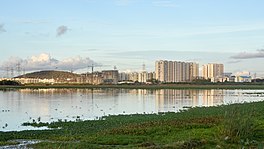| Pallikaranai Marsh | |
|---|---|
 Pallikaranai Marsh at Sholinganallur | |
| Location | Pallikaranai, Chennai, India |
| Coordinates | 12°56′15.72″N 80°12′55.08″E / 12.9377000°N 80.2153000°E |
| Lake type | Wetland |
| Catchment area | 235 km2 (91 sq mi) |
| Basin countries | India |
| Max. length | 15 km (9.3 mi) |
| Max. width | 3 km (1.9 mi) |
| Surface area | 80 km2 (31 sq mi) |
| Water volume | 9 km3 (2.2 cu mi) |
| Surface elevation | 5 m (16 ft) |
| Settlements | Chennai |
| Official name | Pallikaranai Marsh Reserve Forest |
| Designated | 8 April 2022 |
| Reference no. | 2481[1] |
Pallikaranai Marsh is a freshwater marsh in the city of Chennai, India. It is situated adjacent to the Bay of Bengal, about 20 kilometres (12 mi) south of the city centre, and has a geographical area of 80 square kilometres (31 sq mi). Pallikaranai marshland is the only surviving wetland ecosystem of the city and is among the few and last remaining natural wetlands of South India.[2] It is one of the 94 identified wetlands under National Wetland Conservation and Management Programme (NWCMP) operationalised by the Government of India in 1985–86 and one of the three in the state of Tamil Nadu, the other two being Point Calimere and Kazhuveli. It is also one of the prioritised wetlands of Tamil Nadu.[3] The topography of the marsh is such that it always retains some storage, thus forming an aquatic ecosystem. A project on 'Inland Wetlands of India' commissioned by the Ministry of Environment and Forests, Government of India had prioritised Pallikaranai marsh as one of the most significant wetlands of the country.[4] The marsh contains several rare or endangered and threatened species and acts as a forage and breeding ground for thousands of migratory birds from various places within and outside the country. The number of bird species sighted in the wetland is significantly higher than the number at Vedanthangal Bird Sanctuary.[5]
Indiscriminate dumping of toxic solid waste along the road, discharge of sewage, and construction of buildings, railway stations and a new road to connect Old Mahabhalipuram Road and Pallavaram have shrunk the wetland to a great extent. In 2007, as an effort to protect the remaining wetland from shrinking further, the undeveloped areas in the region were notified as a reserve forest.[6][7][8] A 2018 study showed that about 60 percent of the native species in the wetland, including hoorahgrass (Fimbristylis), dwarf copperleaf or Ponnanganni keerai (Alternanthera sessilis), floating lace plant or kottikizhangu (Aponogeton natans), wild paddy (Oryza rufipogon), crested floating heart (Nymphoides), and nut grass (Cyperus), have been replaced by invasive species.[9]
- ^ "Pallikaranai Marsh Reserve Forest". Ramsar Sites Information Service. Retrieved 7 August 2022.
- ^ "Forest Department makes first move to get Pallikaranai marsh declared Ramsar site". The Hindu. 2011. Retrieved 28 September 2011.
- ^ "Wetlands" (PDF). ENVIS Newsletter. 7 (4). Chennai: Department of Environment, Government of Tamil Nadu: 1–8. March 2011. ISSN 0974-133X. Archived from the original (PDF) on 21 March 2012. Retrieved 23 October 2011.
- ^ "Management Plan—Conservation of Pallikaranai Marsh". nammapallikaranai.org. Retrieved 1 September 2011.
- ^ Cite error: The named reference
PallikaranaiInMakeoverModewas invoked but never defined (see the help page). - ^ "Pallikaranai swamp". Conservation of Wetlands, Wetlands of Chennai. C.P.Ramaswami Environmental Education Centre. 2007. Retrieved 24 March 2009.
- ^ Oppili, P. (13 April 2009). "Restoration eluding Pallikaranai marsh". The Hindu. Chennai. Archived from the original on 16 April 2009. Retrieved 23 October 2011.
- ^ Manikandan, K. (21 April 2007). "Major part of marshland now reserve forest area". The Hindu. Chennai. Archived from the original on 27 April 2007. Retrieved 7 December 2011.
- ^ Lakshmi, K. (20 January 2019). "Indigenous flora in city wetlands under threat". The Hindu. Chennai: Kasturi & Sons. Retrieved 3 February 2019.
